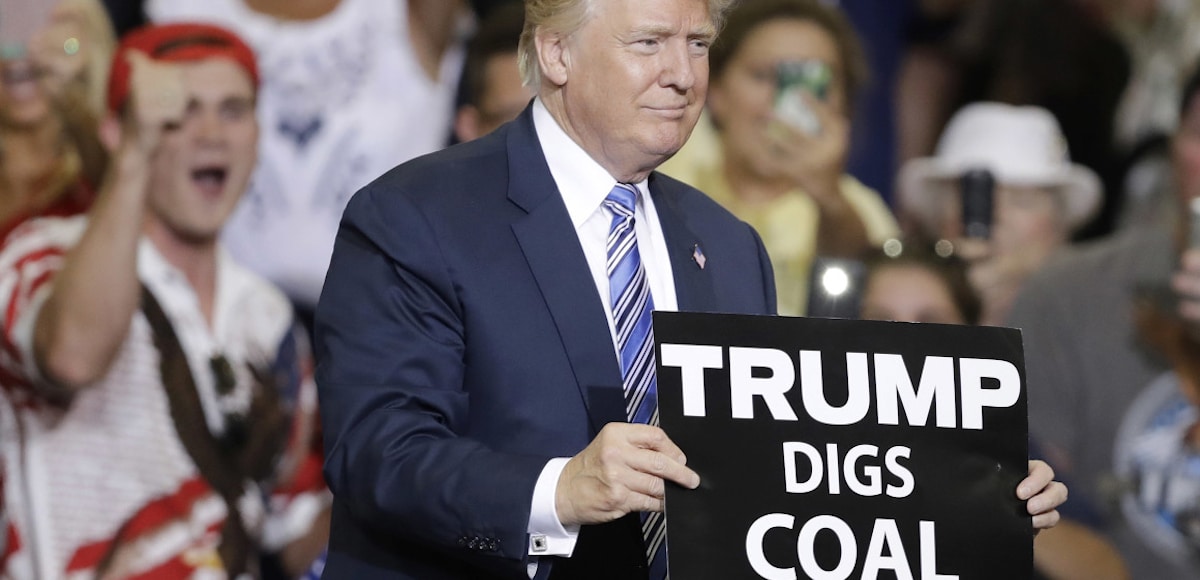

Donald Trump holds up a “Trump Digs Coal” placard at a rally promising to bring back the coal industry in West Virginia, Ohio and elsewhere.
The Trump Administration unveiled the Affordable Clean Energy (ACE) Rule to reduce greenhouse gas (GHG) emissions from existing coal-fired electric utility generating units and power plants across the country. The move is being praised by the coal industry as a job creator and slammed by critics as a polluter.
ACE will rollback and replace Obama-era EPA regulations on emissions from coal-fired power plants. In addition to cutting carbon emissions, it will encourage utilities to invest in cleaner energy sources, such as solar and wind.
“The ACE Rule would restore the rule of law and empower states to reduce greenhouse gas emissions and provide modern, reliable, and affordable energy for all Americans,” said EPA Acting Administrator Andrew Wheeler. “Today’s proposal provides the states and regulated community the certainty they need to continue environmental progress while fulfilling President Trump’s goal of energy dominance.”
The “War on Coal” was a term conservatives and Republicans generally used to describe what the industry calls overly burdensome regulations imposed by the federal government. The EPA under Barack Obama sought to put the mining industry under the boot, resulting in a net negative trend in employment.
That trend under President Trump has now reversed. The ACE rule was developed at the direction of the president, who signed Executive Order 13873. He also signed House Joint Resolution 38 in February 2017 to stop the Stream Protection Rule, another Obama-era policy the industry said was decimating employment.
The proposal will work to reduce GHG emissions through four main actions:
1. ACE defines the “best system of emission reduction” (BSER) for existing power plants as on-site, heat-rate efficiency improvements;
2. ACE provides states with a list of “candidate technologies” that can be used to establish standards of performance and be incorporated into their state plans;
3. ACE updates the New Source Review (NSR) permitting program to further encourage efficiency improvements at existing power plants; and
4. ACE aligns regulations under CAA section 111(d) to give states adequate time and flexibility to develop their state plans.
A 2015 study found the U.S. coal industry lost 50,000 jobs from 2008 to 2012 during Obama’s first term. By September 2016, America had 83,000 fewer coal miners employed. By the end of Obama’s presidency, 600 coal mines had closed.
As a result, U.S. coal production declined by more than 177,000,000 tons, raising the cost of electricity on Americans of all incomes and leaving the country vulnerable to blackouts.
“EPA has an important role when it comes to addressing the CO2 from our nation’s power plants,” said Assistant Administrator for the Office of Air and Radiation Bill Wehrum. “The ACE rule would fulfill this role in a manner consistent with the structure of the Clean Air Act while being equally respectful of its bounds.”
The EPA said the proposed ACE Rule is informed by more than 270,000 public comments received as part of its December 2017 Advance Notice of Proposed Rulemaking (ANPRM).
The agency’s RIA, or regulatory impact analysis, includes a variety of scenarios when states have the flexibility needed to consider unit-specific factors – including a particular unit’s remaining useful life – when it comes to standards of performance.
Key findings include the following:
• EPA projects that replacing the CPP with the proposal could provide $400 million in annual net benefits.
• The ACE Rule would reduce the compliance burden by up to $400 million per year when compared to CPP.
• All four scenarios find that the proposal will reduce CO2 emissions from their current level.
• EPA estimates that the ACE Rule could reduce 2030 CO2 emissions by up to 1.5% from projected levels without the CPP – the equivalent of taking 5.3 million cars off the road. Further, these illustrative scenarios suggest that when states have fully implemented the proposal, U.S. power sector CO2 emissions could be 33% to 34% below 2005 levels, higher than the projected CO2 emissions reductions from the CPP.
EPA will take comment on the proposal for 60 days after publication in the Federal Register and will hold a public hearing.







